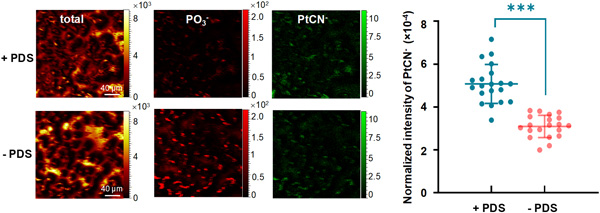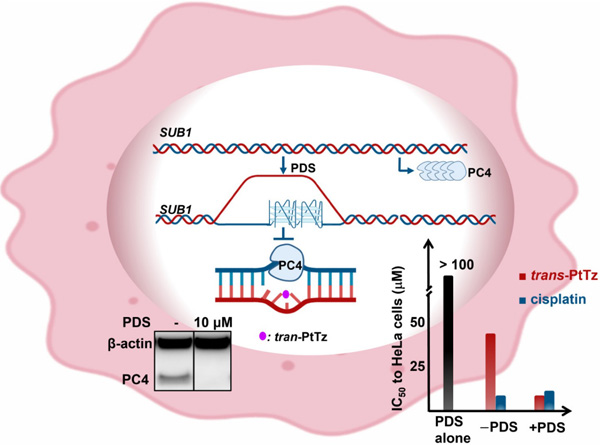Researchers Reveal New Molecular Mechanisms for Platinum Based Anticancer Agents
Metal based anticancer drugs can damage DNA and induce a series of cell stress response, an important one of is that some nuclear proteins recognize the damage and mediate the repair of DNA lesion. The researchers from the CAS Key Laboratory of Analytical Chemistry for Living Biosystems, the Institute of Chemistry, Chinese Academy of Sciences previously discovered that the human positive cofactor (PC4) specifically recognize trans-platinum complexes (trans-PtTz) damaged DNA, which may regular the cellular responses of DNA damage by trans-PtTz (J. Am. Chem. Soc., 2014, 136, 2948?2951), but the function of this recognition is still open to doubt.
Most recently, they discovered that Pyridostatin (PDS), a well-known G-quadruplex (G4) inducer and stabilizer, could significantly downregulate the expression of PC4 in HeLa (human cervical cancer) cells. Subsequently, they discovered that PDS could enhanced the anticancer activity of trans-PtTz. Considering the previous results, they applied various methods to explore the mechanism of action by PDS. They demonstrated that the specific binding of PC4 with trans-PtTz damaged DNA could initiate DNA lesion repair, and PDS could inhibit this repair by downregulating PC4, which significantly increase the accumulation of Pt in cells (Figure 1), so as to enhance the anticancer activity of trans-PtTz (Figure 2).
This work is supported by the National Natural Science Foundation of China, the Key Research and Development Program of China, the Youth Innovation Promotion Association of CAS, and the China Postdoctoral Science Foundation. This research progress was recently published in Nucleic Acids Res., 2022, 50, 3070–3082, entitled “G-quadruplex inducer/stabilizer pyridostatin targets SUB1 to promote cytotoxicity of a transplatinum complex”.

Figure 1. ToF-SIMS images of HeLa cells treated with trans-PtTz in the presence (+) and without (-) of PDS, showing that the accumulation of Pt in PDS pretreated HeLa cells were increased. (Imaged by HOU Yizhu and FANG Tiantian ). 
Figure 2. PDS downregulates the expression of PC4, and inhibits the repair of trans-PtTz damaged DNA, so as to increase the anticancer activity of trans-PtTz. (Imaged by HOU Yizhu and WANG Fuyi).
Contact:
Prof. WANG Fuyi, Associate Prof. ZHAO Yao
Institute of Chemistry, Chinese Academy of Sciences
Email: fuyi.wang@iccas.ac.cn, yaozhao@iccas.ac.cn





